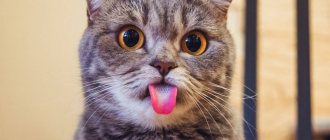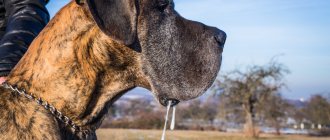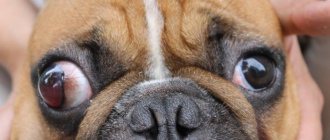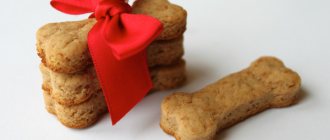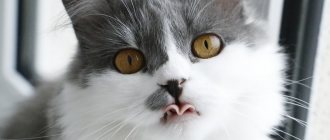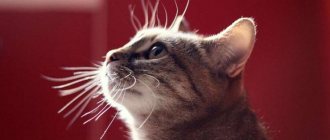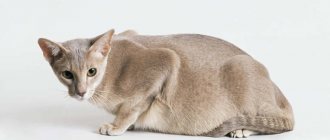Physiological change of teeth
Kittens are born toothless. Their primary incisors erupt at the age of 1-2 weeks. A two-month-old baby should already have at least 26 teeth. But they begin to fall out at 3-4 months. The change process also lasts 3-4 months, ending at 7 months.
Monitor your baby's health, count how many and which teeth have fallen out. An adult cat should have 30 of them: 6 incisors, 2 canines, 2 molars on the lower and upper jaws. There are 10 premolars: 6 on the lower jaw and 4 on the upper jaw.
When changing baby teeth, a cat may experience symptoms such as:
- hypersalivation;
- chewing inedible objects;
- decreased activity;
- irritability, excitability.
Often the process of changing teeth occurs with complications - instead of 4 fangs, 8 grow. This is due to the fact that the formation of molars occurs in separate follicles: the milk ones have not yet fallen out, but new ones are already actively growing. The kitten experiences discomfort, cannot chew and therefore loses weight.
In such cases, you need to go to the clinic to have a specialist remove the loose tooth. The procedure is performed under anesthesia.
Change of teeth, which takes place without complications, does not require medical intervention. The main thing is that the dishes in the baby’s diet contain the required amount of mineral salts, calcium and phosphorus.
Causes of tooth loss in adult cats
It is easy to distinguish baby teeth from permanent ones: the first ones are white, sharp, like needles. They are slightly flat, and there is a slight thinning where the tooth meets the gum. The fangs are curved back. Indigenous (permanent) have a yellowish tint, with a more rounded cross-section. The canines are straight, there is no thinning in the gum area.
If a cat is kept in good conditions, receives a balanced diet enriched with nutrients, vitamins and microelements, and is not exposed to external traumatic factors, it may well retain its teeth into old age.
However, if a pet loses them after it is 1 year old, that is, we are talking about the loss of permanent teeth, this is an alarming signal, indicating the presence of serious pathologies occurring in the body.
It is important to understand: adult cats’ teeth do not simply fall out. This is a problem not only of the oral cavity, but also of the whole body, since the mucous membrane of the mouth and gums have many blood vessels through which the infection spreads throughout the body.
By the age of three, a cat’s dental plaque turns into stone, so the oral cavity needs careful care - cleansing with special pastes. If hygiene procedures are neglected, tooth loss cannot be avoided in the future.
Tooth loss in an adult animal may indicate the following problems in the body:
- injuries in the mouth;
- weakening of the immune system;
- disruption of the natural microflora in the oral cavity, colonization of it by pathogenic bacteria;
- vitamin deficiency;
- diabetes mellitus;
- tartar;
- metabolic disorders;
- changes in hormonal levels (pregnancy, taking hormonal medications, including contraceptives, antibiotic therapy, etc.);
- dental diseases (gingivitis, periodontal disease, caries, etc.);
- malocclusion;
- gastrointestinal pathologies;
- oncology.
The idea that all cats lose their incisors in old age is wrong. If the animal is healthy, the onset of old age is not an argument for poor dental health. The exception is the age of 20 years and older, but a rare cat survives to that age.
The loss of the chewing apparatus of its structural units is associated with diseases, poor care and unbalanced nutrition, but not with age.
Over the years, various changes in the condition and shape of teeth still occur. It has been proven that the approximate age of a cat can be determined by the number of worn teeth - the more teeth there are, the older the animal.
The first to wear off are the incisors on the lower jaw (towards the edges from the center), their shape becomes transversely oval. Then comes the turn of the molars and premolars. The last ones to lose enamel are the fangs.
Preventive measures
Avoiding such problems is much easier than dealing with their consequences later. To this end, it is worth following a number of recommendations.
Regular teeth cleaning
To avoid the formation of tartar, it is recommended that your pet regularly brush its teeth.
True, cats walking outside clean their mouths themselves. They have it in their nature. We are talking about pets. For this purpose, special pastes are used, which are available at the veterinary pharmacy. There is no need to wash them off with water.
The use of human hygiene products is prohibited. Cleaning is done with a special or children's brush. The main thing is that the bristles are soft.
Balanced diet
If the owner feeds the animal with natural food, then the pet’s menu should include fermented milk products, vegetables, fish and meat.
When using dry food, the choice is made on premium products. It contains the necessary concentration of nutrients.
Regular examinations by a specialist
At least once a year you need to visit a veterinary clinic and have your pet examined. In this way, it will be possible to identify the disease at the initial stage of its development.
Main symptoms
The clinical picture of tooth loss varies depending on the cause that caused this phenomenon. If a structural unit of the chewing apparatus falls out due to injury, it is enough to treat the wound with a disinfectant solution, and if it does not become infected, the damaged area will heal safely.
The following symptoms are reasons to contact a veterinary clinic:
- gums swell, redden, bleed;
- saliva is released abundantly, which is why the cat’s face and neck are constantly wet;
- ulcers form in the oral cavity;
- pus in saliva;
- a foul smell of rotting emanates from the mouth;
- presence of difficulties with chewing;
- lack of appetite.
As a rule, the cat’s behavior changes, he becomes restless, apathetic, and loses weight. The animal refuses food, even if it is very hungry. If a cat tries to eat, he does it very carefully and slowly, as chewing causes him discomfort. As a rule, he also refuses water.
The owner should observe the condition of the animal; it is advisable to write down changes in order to tell the veterinarian about them. This will greatly facilitate diagnosis and determine treatment.
Treatment method and prognosis
There is no single treatment regimen. Therapy is compiled individually in each specific case and depends on the age of the cat, its state of health and the cause of tooth loss. A lost tooth cannot be restored; the veterinarian’s task is to prevent subsequent losses.
To solve the problem, the specialist makes adjustments to the cat’s diet and prescribes medications to strengthen the teeth and immune system.
Regarding vitamin therapy, we can say that there is no need to give vitamin C in loading doses. In cats, ascorbic acid is synthesized in sufficient quantities, so they do not develop scurvy.
If the animal has tartar, it is removed in the clinic. The procedure is performed under anesthesia, for which premedication is used - the administration of anticholinergic drugs to block vagal reflexes. These drugs cause the least harm to the animal’s body. During the operation, the cat will be conscious, but will not be able to resist.
After recovering from anesthesia, your pet will need quality care, as the procedure is stressful for him.
In parallel with this, treatment is carried out aimed at strengthening the gums and reducing their bleeding. But the main emphasis is on eliminating the underlying disease that caused tooth loss.
How is the diagnosis carried out?
The process is not considered an independent disease, but a symptom of a serious disease affecting the body.
The exception is injuries sustained. Diagnostic measures are aimed at determining the cause of such changes.
Read also: How is a navel piercing done in a salon?
The veterinarian collects information about the cat’s diet and living conditions and listens to the owner’s complaints.
A visual examination of the pet is also carried out, and additional tests may be prescribed.
What to do at home
The owner is required to strictly follow the veterinarian's instructions. Self-medication is dangerous for the cat’s health and can cause irreparable harm to it. Medicines and their dosage are determined by a specialist.
In order for the animal to lead a normal lifestyle, it is necessary to change the consistency of the food, since dry hard granules can further injure the oral cavity.
The oral cavity is regularly examined and treated with a disinfectant solution of Chlorhexidine. These procedures prevent infection of the enamel and damage to other teeth.
Features of the cat's dental system
The cat is a predator that hunts small rodents, kills them and eats their flesh. Due to this form of nutrition, the dental system of a predator has a special structure. The incisors are practically not involved in hunting and chewing food and therefore are small in size. Cats use them to catch fleas and bite dirt out of their fur coats.
The most significant in size are the fangs. These long, sharp teeth are essential for holding onto caught prey. They are slightly curved inside the oral cavity and are also used for protection. The loss of fangs is tantamount to the loss of weapons. A predator cannot kill its prey and tear it apart. If the fangs are lost, the animal will have to be content with carrion.
Molars and premolars are saw-shaped. Their sharp cutting edges help to cut meat and cut it off the bones. Due to the lever action of the jaw joints, the cheek teeth act like scissors. The upper part of the crown of a cat's cheek tooth is sharper than that of some members of the canine family.
The cat does not chew its food because it is not necessary. Her saliva does not contain digestive enzymes. The enzymes needed to digest protein foods could also dissolve oral tissue. Therefore, predators simply swallow large pieces.
Natural selection is very rational and cruel, therefore, in the wild, a predator that has lost the ability to feed and defend itself dies.



